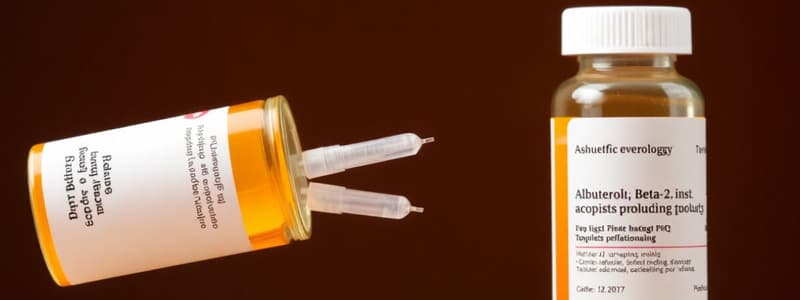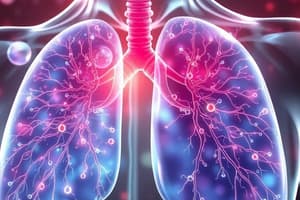Podcast
Questions and Answers
A patient with a history of cardiac arrhythmia requires a SABA for asthma exacerbation. Which medication would be most appropriate?
A patient with a history of cardiac arrhythmia requires a SABA for asthma exacerbation. Which medication would be most appropriate?
- Formoterol (Foradil)
- Levalbuterol (Xopenex) (correct)
- Salmeterol (Serevent)
- Albuterol (ProAir)
A patient is prescribed salmeterol (Serevent) for asthma. What crucial information should the healthcare provider emphasize regarding its use?
A patient is prescribed salmeterol (Serevent) for asthma. What crucial information should the healthcare provider emphasize regarding its use?
- It should be used as a rescue inhaler during acute asthma symptoms.
- It is safe for short-term use to manage exercise-induced bronchospasm.
- It must be combined with an inhaled corticosteroid (ICS) for asthma. (correct)
- It can be used as a monotherapy to control asthma symptoms.
A patient reports using their albuterol inhaler (ProAir) four days a week for asthma symptoms. What does this frequency of use suggest?
A patient reports using their albuterol inhaler (ProAir) four days a week for asthma symptoms. What does this frequency of use suggest?
- Excellent asthma control.
- Normal asthma control.
- Possible need for increased SABA use.
- Inadequate asthma control. (correct)
Which of the following best describes the mechanism of action of beta-2 agonists in treating asthma?
Which of the following best describes the mechanism of action of beta-2 agonists in treating asthma?
A patient is switched from albuterol to levalbuterol. What is the primary reason for this change, assuming both medications are effective for the patient's asthma?
A patient is switched from albuterol to levalbuterol. What is the primary reason for this change, assuming both medications are effective for the patient's asthma?
Flashcards
Albuterol
Albuterol
A short-acting beta-2 agonist used for quick relief of asthma symptoms.
SABA
SABA
Short-Acting Beta-2 Agonists; used for immediate asthma relief.
Levalbuterol
Levalbuterol
A rescue inhaler for asthma and COPD, with fewer side effects than albuterol.
LABA
LABA
Signup and view all the flashcards
Salmeterol
Salmeterol
Signup and view all the flashcards
Study Notes
Short-Acting Beta-2 Agonists (SABAs)
-
Albuterol (ProAir®, Ventolin®, Proventil®): Used for quick relief of asthma symptoms and exercise-induced bronchospasm.
-
Mechanism: Stimulates beta-2 adrenergic receptors in bronchial smooth muscle, causing bronchodilation.
-
Pharmacokinetics:
- Onset: 5-15 minutes
- Duration: 4-6 hours
- Metabolism: Liver; excretion in urine
-
Use: PRN (as needed). Frequent use (>2 days/week) may indicate poor asthma control.
-
Side effects: Tremors, tachycardia, hypokalemia.
-
Levalbuterol (Xopenex®): Rescue inhaler for asthma and COPD. Has fewer beta-1 effects.
-
Mechanism: Selectively stimulates beta-2 receptors, leading to bronchodilation (R-enantiomer of albuterol).
-
Pharmacokinetics:
- Onset: 5-10 minutes
- Duration: 3-6 hours
- Metabolism: Hepatic; excretion in urine
-
Side effects: Less tachycardia than albuterol.
Long-Acting Beta-2 Agonists (LABAs)
- Salmeterol (Serevent®): Maintenance therapy for moderate-to-severe asthma and COPD, always in combination with inhaled corticosteroids (ICS).
- Mechanism: Selectively stimulates beta-2 receptors, prolonging bronchodilation.
- Pharmacokinetics:
- Onset: 30-60 minutes
- Duration: 12+ hours
- Metabolism: Hepatic (CYP3A4)
- Black Box Warning (BBW): Increased risk of asthma-related death if used without inhaled corticosteroids (ICS).
Inhaled Corticosteroids (ICS)
-
Fluticasone (Flovent®, Arnuity®): First-line maintenance therapy for persistent asthma.
-
Mechanism: Inhibits inflammatory cytokines, reducing airway inflammation.
-
Pharmacokinetics:
- High first-pass effect, low systemic absorption
- Metabolism: Hepatic (CYP3A4)
-
Use: Long-term asthma control
-
Side effects: Oral thrush, if patients do not rinse their mouth after use. May take 1-2 weeks for full effect.
-
Budesonide (Pulmicort®): Long-term control of asthma and COPD.
-
Mechanism: Suppresses airway inflammation by reducing inflammatory cell activity.
-
Pharmacokinetics:
- Onset: Several days to weeks
- Preferred ICS in pregnancy; available as a nebulizer
-
Metabolism: Hepatic (CYP3A4)
Antimuscarinic Agents
- Ipratropium Bromide (Atrovent®): Short-acting (SAMA), used for COPD maintenance therapy and asthma exacerbation, combined with a SABA.
- Mechanism: Blocks muscarinic (M3) receptors to prevent bronchoconstriction.
- Pharmacokinetics:
- Onset: 15 minutes
- Duration: 4-6 hours
- Tiotropium (Spiriva®): Long-acting (LAMA), used for maintenance therapy of COPD and severe asthma.
- Mechanism: M3 receptor antagonist reducing bronchoconstriction and mucus secretion.
- Pharmacokinetics:
- Duration: 24 hours
Leukotriene Receptor Antagonists
- Montelukast (Singulair®): Asthma prophylaxis, allergic rhinitis, Exercise-induced asthma.
- Mechanism: Blocks leukotriene D4 receptors, reducing airway inflammation and bronchoconstriction.
- Pharmacokinetics:
- Hepatic metabolism (CYP2C9, CYP3A4)
- Black Box Warning (BBW): Neuropsychiatric events (mood changes, aggression).
- Use: Second-line option to inhaled corticosteroids (ICS)
Biologics (Severe Asthma)
-
Omalizumab (Xolair®): For severe allergic asthma.
-
Mechanism: Binds to IgE, preventing mast cell activation.
-
Pharmacokinetics: SC every 2-4 weeks.
-
Black Box Warning (BBW): Anaphylaxis risk; patients must be observed after injection
-
Mepolizumab (Nucala®): Eosinophilic asthma - targets IL-5.
Phosphodiesterase-4 (PDE-4) Inhibitors
- Roflumilast (Daliresp®): Severe COPD with chronic bronchitis.
- Mechanism: Inhibits PDE-4, reduces inflammation.
- Pharmacokinetics: Oral once daily.
- Side effects: GI distress, weight loss, psychiatric symptoms.
Intranasal Corticosteroids for Allergic Rhinitis
- Fluticasone (Flonase®): for allergic rhinitis,
- Mechanism: Reduces nasal inflammation.
- Pharmacokinetics: Low systemic absorption
Decongestants
- Oxymetazoline (Afrin®): For nasal congestion.
- Mechanism: Alpha-adrenergic agonist, causing nasal vasoconstriction.
- Pharmacokinetics:
- Onset: Minutes
- Duration: 12 hours
- Use: Limit use to 3 days to prevent rebound congestion (rhinitis medicamentosa).
Studying That Suits You
Use AI to generate personalized quizzes and flashcards to suit your learning preferences.




